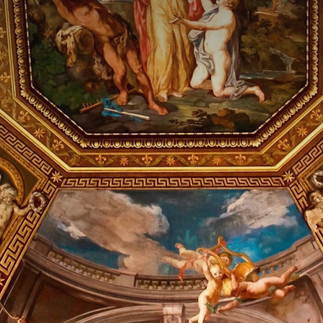Stop calling EVERYTHING Art.
- Antara
- Oct 7, 2024
- 6 min read
The task of defining art has proven to be elusive throughout history. Traditional definitions often emphasise attributes such as creativity, technical skill, and aesthetic value. However, these criteria are not universally applicable, especially given the emergence of avant-garde movements and conceptual art that has pushed the boundaries of these conventional definitions, questioning whether anything can be considered art. Categorically, art can be defined in either through formalist or antiformalist theories where the former emphasises formal qualities such as composition and colour whilst the latter prioritises artistic message, concept and context. However, importantly, everything with a message to the audience cannot be categorised into art. Those who know me are indeed well aware of my overt distaste for the modern art movement- I strongly advocate that a certain level of artistic proficiency and craft must be evident to define a creation as artwork, as ultimately one of the main purposes of art is to be captivating - a vessel to stir aesthetic emotion. When did we forsake the timeless grandeur of artistic masterpieces by Raphael and Michelangelo in favor of ephemeral, unrefined modern art? Better yet then, what do we define now as good art?
Leo Tolstoy’s theory of aesthetics focuses on the idea of art being about shared communion and emotion from the audience not just those of today but of generations after as well ; the communion that art evokes should be timeless. He defines successful art as a “means of communication” between the artist and the audience or between other audience members who have experienced the art and firmly rejects the idea of art being aesthetic pleasure ; it must evoke true, deep emotion. Tolstoy's central requirement for authentic art focuses on iskra (a spark), the “quality of infectiousness” and intrigue that moves and elicits emotion from the audience is what truly defines the piece as art. He notes that this sharing is almost “involuntary, like radiation”. A potent example of this is Picasso’s “Guernica” that depicts the horrors of the bombing during the Spanish Civil War. Through its stark imagery and symbolic representations of suffering, Guernica sparked a powerful anti-war message within the audience and at the time elicited a sharp response in viewers and governments to object to the oppressive Spanish authorities, and still to this day causes audiences to contemplate the human cost of conflict as it incites within them the spark of hurt and pain illustrated by the victims of war. Hence true art is that which conveys specific artistic intention and emotion to an audience and elicits a communal emotional response. However Tolstoy’s characterisation, though effective, is flawed. It is important to consider firstly that art is often not created to be displayed for a wide audience but rather as a means of catharsis hence defining it with a necessity for viewership seems implausible. In a simple response, whilst a creation may originate from the personal catharsis of the artist, its true significance lies in its ability to connect with and resonate with an audience. Good art is relevant and impactful as each viewer brings their own unique perspectives, beliefs, and experiences to their interpretation, enriching the artwork with layers of complexity and depth. . If we never see a masterpiece, we cannot appreciate it as a masterpiece in the same way if we never see art, we cannot claim it to be art. It may, indeed, have significant meaning to the artist who can project the title of art onto it, but if the creation is not communicated with more than one person then it loses its ability to be critiqued and disliked, to be seen as something else entirely which is needed in art. Art cannot be something that is wholly good nor wholly bad but rather multifaceted thus we establish an audience is necessary to define what constitutes art.
Secondly, the idea of the audience experiencing the same communal feeling as a means to define something as art (as put forward by Tolstoy) is further unconvincing because as outlined above, human beings perceive the same paintings through different lenses of experience, adding layers of subjectivity : what aesthetic emotions are incited in one person may be completely different to that of another. Part of the beauty of art is that it will be complex enough to have many facets and that the audience may take away different messages from it, sometimes ones that contradict the original artistic intention ; this does not negate the creation as art but rather increases its value that it is able to evoke such polarising emotion.
However the largest criticism to Tolstoy’s theory leads to a consideration of a different attempt to define art altogether : a formalist theory. Though I believe Tolstoy is correct in that exposure to an audience is essential to what defines good art, in reality any creation will draw a profound response from some person or group of people in this world. Does that necessarily make it art? Indeed not. After all, a banana taped to a wall (the infamous conceptual artwork by Maurizio Cattelanis) is indeed most peculiar. Michelangelo did not suddenly become a brilliant sculptor merely because he had a feeling that he wanted to transmit to others that was collectively received based on his message. He became a master sculptor and painter because he worked to gain the expert skills he needed to create masterpieces like the statue of David and the roof of the Sistine Chapel. Artistic emotion no doubt played a role in the drive to make those works, but he had to utilise skill and mastery to produce them : a mere transmission of feeling is not enough to make something art. This posits the idea that a level of artistic proficiency is required in defining a creation as art otherwise we fall into the trap of trying to consider everything as art.
A known formalist, Clive Bell in his theory of aesthetics tells us that art is defined as pieces that provide the audience with “aesthetic emotions'', the emotional attitude we have in response to “significant form” which Bell notes are lines, colours and the arrangement of shapes and figures combined or related in a particular way that stir said aesthetic emotions. He argues significant form cannot be random or subjective and has to be skilled and masterful; the audience should be formalists who try to understand form ; provenance or historical background are not important as to appreciate a work of art all one needs is a sense of colour and space. In his words, significant form uncovers the “God in everything . . . the all-pervading rhythm” behind the appearances of things, the “echo of some more ultimate harmony”. Hence Bell very much appreciates the craft and the technical skill such as proportionality and colour theory behind artwork, which is strong in the fact that it rightly disregards lots of modern art that seems rather lacking in artistic skill, for example Tracey Emin’s “my bed”, in my view, whilst may convey the profound message of habits one falls into during depression, there is nothing visually stimulating or wondrous about it skilfully ; it loses its value in the fact that it seems a creation that the audience could have put together themselves. I believe true art has one layer of removal from the audience creating wonder in the piece because it could only have been created by someone highly trained in the craft.
However naturally, by emphasising form as key in defining art, Bell also turns a blind eye to art with political and social intent behind it (conceptual art) that is meant to be appreciated beyond a surface level beauty. Cuban-born American visual artist Félix González-Torres was known for his minimal installations, addressed to cultural, gay activism, in which he used light bulbs expiring and piles of candies as metaphor for the process of dying and regeneration. It was to specifically make the point of how governments, by perpetuating intrastate homophobic policy and attitude, were causing the “light” in each LGBTQ+ person to die out : they were killing percentages of their populations. Now this is very simple and lacks craft, but does indeed send a powerful message. However, what I question is why can’t there be both? Art should be that which is skilful and that conveys a distinct message to the audience which evokes aesthetic emotion.
This in fact tells us that good art cannot be defined in a binary way. It is not just that which evokes a communion in aesthetic emotions and not just one that is intricate in form but also bears no meaning behind it. It must be an amalgamation of them both. Good art can hence be defined as a creation with significant form and an expert demonstration of the study of art, but must also convey a feeling, a sentiment or a message to an audience.


















People have such lost standard these days. And nomenclature is dime a dozen. So anything goes.
Great piece!
Makes total sense. Well debated and might I say.... you won!
Great piece Antara. Everybody and their mothers have now become art. Kind of ridiculous.
I too hate modern art. Well argued!!
Thoughtful piece and its time some one called this out for what it has become -a sham!